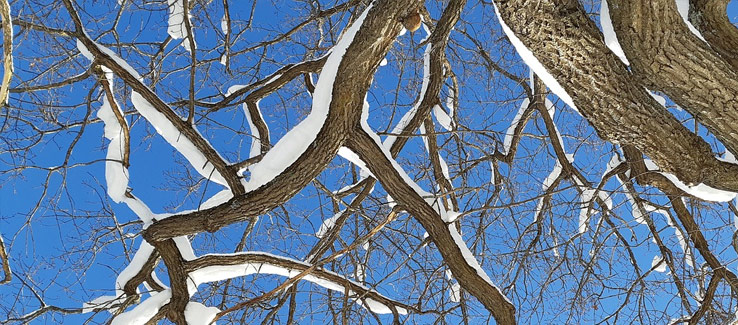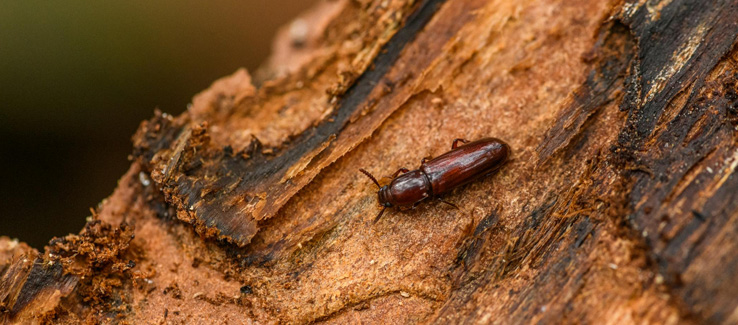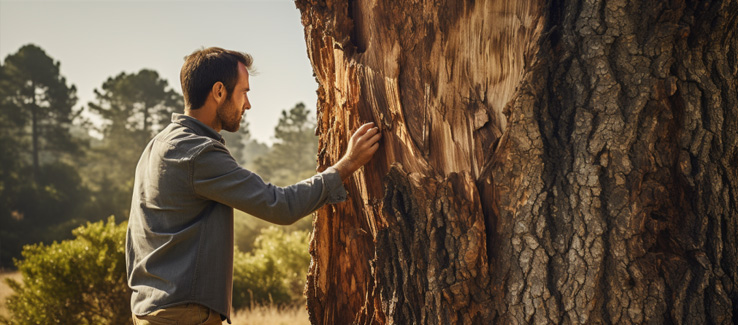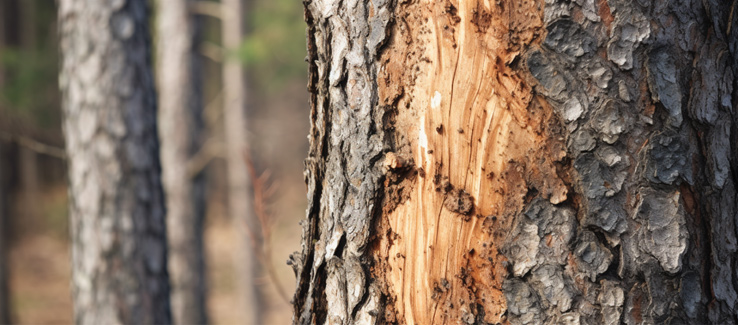Why Is the Bark Peeling Off My Tree?
Picture this: you’re strolling through your yard or a nearby park, and you spot tree bark peeling away in substantial chunks, revealing the wood underneath. If you’ve come across this scene before – something we’ve witnessed numerous times – you might have asked yourself, ‘What’s causing my tree’s bark to peel off?’ and questioned whether it’s a distress signal from your beloved tree. No need to fret because we’re here to unravel the reasons behind this and provide the knowledge required to nurture your green companions.
Key Points of Tree Bark Peeling
- Having a grasp of the natural process of tree bark shedding is essential for identifying potential environmental stressors or tree diseases.
- Some tree species naturally shed their bark as they grow, while fruit and nut trees may experience bark peeling due to significant temperature variations.
- Maintaining a watchful eye on the condition of trees displaying bark peeling is imperative.
- If you need more clarification, seek guidance from a tree service or certified arborists to safeguard the health of your valuable trees.
What Does A Tree Shedding Bark Mean?
While observing peeling tree bark can be disconcerting, it doesn’t necessarily indicate a tree in distress. In fact, many tree species naturally shed their bark as part of their growth and adaptation to their environment. Additional factors, including temperature fluctuations and the inherent characteristics of specific trees, can also contribute to bark shedding.
So, the question remains: How can you determine whether your tree’s bark shedding is a regular part of its healthy growth process or a potential symptom of disease or environmental damage? The answer lies beneath the outer layer.
Finding a healthy, fresh layer of bark covering the wood as the old bark peels away is a positive sign that your tree is going through a routine and healthy shedding process. However, uncovering bare wood or noticing fungal growth underneath the peeling bark may suggest environmental damage or disease impacting the tree. In such cases, it’s advisable to seek guidance from a tree specialist. Identifying the underlying issue is crucial, as it allows you to take timely measures to safeguard your tree from further harm.
Natural Reasons For Tree Bark Shedding
Trees like the silver maple and sycamore naturally tend to shed their bark as an integral part of their growth and development. In fact, several other tree species are known for their natural bark shedding, including:
- London planetree
- Kousa dogwood
- American sycamore
- Paperbark maple
- Silver maple
- Scots pine
- Redbud
The process of natural bark shedding can sometimes be confused with bark splits, particularly when viewed from beneath the tree’s surface. In some instances, dead bark sloughs off, exposing the underlying wood. It’s crucial to distinguish between these occurrences and loose bark, as they may indicate different issues. One effective way to differentiate is by observing naturally shed bark around the tree with thick, healthy bark.
This natural shedding promotes the growth of fresh, vibrant bark while discarding older, deceased layers. It’s an entirely natural and vital phenomenon that contributes to the overall well-being of the tree. Therefore, when you come across bark shedding in these species, you can be confident that it signifies growth and robust health.
Bark Peeling Due To Weather
Drastic temperature variations, along with sudden shifts, can trigger bark shedding, especially in fruit and nut trees. Two frequent temperature-related causes of bark peeling are frost cracks and sunscald. These factors can expose the tree’s inner layers, rendering it more susceptible to pests and diseases. Thus, protecting your trees in winter and extreme weather is vital to their long-term health.

To reduce the risk of bark shedding related to temperature, it’s crucial to diligently monitor your tree’s exposure to extreme weather conditions. Offering shade during hot afternoons and safeguarding the trunk from freezing temperatures are proactive steps that can help preserve your tree’s well-being and decrease the likelihood of bark peeling.
How Do Warm Seasons Affect Trees With Thin Bark
Trees characterized by thin bark, like maple and pine trees, tend to experience more frequent shedding, especially in the warmer seasons. This heightened shedding is a natural process that enables the tree to capture additional sunlight, which, in turn, supports its growth.
Therefore, if you happen to observe your thin-barked tree shedding more profusely than usual during the warmer months, there’s no cause for alarm – it’s simply nature’s way of nurturing the tree’s development.
The Role Insects and Diseases Have On Tree Bark
While bark shedding can indeed be a natural occurrence for specific tree species and under certain environmental conditions, it’s crucial to recognize that diseases and pests can also be responsible for the loss of a tree’s protective bark layers. Pinpointing the underlying cause of bark shedding is paramount to preventing further harm and ensuring the tree’s continued well-being.
Fungal infections, such as Cytospora canker and Botryosphaeria, as well as insect-related damage from defoliating, burrowing, and sap-sucking pests, all have the potential to result in bark peeling. In the upcoming sections, we’ll delve deeper into these issues and provide insights on how to identify and effectively address them.
Fungal Infections VS. Bark Peeling
Fungal diseases, such as Hypoxylon canker, can result in symptoms like bark peeling, yellowing leaves, and the decline of branches. When you suspect a tree might be afflicted by a fungal ailment, it’s advisable to closely examine the bark for indications of infection, including a whitish or grayish discoloration combined with wilting leaves.
Upon diagnosing your tree with a fungal infection like Hypoxylon canker, it becomes essential to follow these necessary steps:
- Safely remove the infected tree.
- Dispose of the affected wood in a proper manner to prevent the fungus from spreading.
- Take swift action to protect neighboring trees from infection and to prevent any further ecological damage.
Harmful Role Insects Can Have On Tree Bark
Insects, such as beetles and spotted lanternflies, can have a detrimental impact on tree bark. Their egg-laying activities can lead to bark disruption and peeling, which leaves the tree susceptible to potential infestations. Various insects are known to be responsible for damaging tree bark, including:
- Borers
- Bark beetles
- Clearwing moths
- Other tree-boring insects

To shield your tree from insect-related harm, it’s advisable to thoroughly examine the bark for signs of infestation, such as small holes or the presence of sawdust-like debris around the tree. Suppose you come across any evidence of insect damage. In that case, it’s wise to seek the expertise of a tree care specialist or an arborist who can accurately diagnose and treat the issue, ensuring your tree’s continued health and survival.
How The Environment Affects Tree Bark Peeling
In addition to the inherent growth patterns and diseases, various environmental factors, such as sunscald, frost damage, and water stress, can play a role in causing tree bark to peel. Recognizing and proactively addressing these environmental factors is pivotal for your tree’s overall well-being and extended life, as bark peeling triggered by these influences can lead to subsequent complications.
In the upcoming section, we will delve into how sunscald, frost damage, and water stress can induce bark peeling and explore preventive strategies to nurture your tree’s thriving resilience in the face of these environmental challenges.
Sunscald and Frost Damage
Bark peeling can be a result of both sunscald and frost damage, particularly on the tree’s south or southwest side. Sunscald occurs when the warm afternoon sun triggers the tree to exit its dormant phase, and subsequent freezing nighttime temperatures cause damage to the newly awakened tissue, resulting in unsightly markings on the trunk.
To protect your tree from sunscald and frost damage, consider applying preventive measures such as wrapping or painting the tree’s trunk. This approach serves as a protective barrier against temperature fluctuations, ensuring the tree’s overall well-being and visual appeal.
Bark Cracking Due To Water
Water stress, resulting from either overhydration or insufficient water, is a potential cause of bark cracking and peeling. It is vital to ensure that your tree receives the right amount of water to maintain its health and overall well-being.
Adhering to appropriate watering methods can alleviate water stress and thwart bark issues. Opt for deep, infrequent watering sessions, allowing the soil to dry between each watering cycle. This practice encourages the development of deep roots, enhancing the tree’s resilience during both dry spells and periods of excessive moisture.
Caring For Trees With Peeling Bark
While taking care of trees that have bark peeling might seem challenging, with the right knowledge and approach, you can help your tree flourish despite any issues it may encounter. Keeping an eye on your tree’s well-being and seeking professional assistance when necessary can significantly contribute to its overall health.

In the following section, we’ll provide guidance on how to monitor your tree’s health and when to consult a tree care specialist for expert support.
Inspecting Trees to Maintain Tree Health
Make it a habit to routinely examine your trees for indications of diseases, pests, or environmental challenges. Be on the lookout for changes like leaf discoloration, drooping foliage, or bark peeling. When you observe any of these indicators, it becomes vital to take steps to sustain your tree’s well-being. This may entail activities such as trimming, fertilizing, or administering appropriate treatments like pesticides.
Devoting time to inspect your trees and addressing concerns in their early stages can be instrumental in averting more significant issues in the future. Adopting a proactive approach to tree care will ensure the continued vitality and endurance of your beloved green companions.
Contacting A Professional For Tree Help
If you find yourself uncertain about the reasons behind bark peeling or how to best tend to your tree, don’t hesitate to reach out to a tree care expert for insights and support. Professionals in this field, like certified arborists, are well-equipped to analyze the issue and offer the necessary guidance or treatments.
In case you suspect your tree is facing potential disease or environmental harm, it’s a wise decision to get in touch with a tree care specialist. Their knowledge and experience can assist you in preserving the well-being and visual appeal of your tree, ensuring it continues to be a vital part of your landscape for years to come.
Conclusion
Bark shedding in trees can result from the natural progression of a tree’s growth, indicate the presence of a disease or pest infestation, or stem from environmental factors such as sunscald, frost damage, or water stress. By gaining insight into the diverse reasons behind bark peeling and implementing preventative actions, you can play a pivotal role in preserving the health and endurance of your trees.
It’s crucial to keep an eye on your trees’ well-being, take proactive steps to resolve concerns, and, when necessary, consult a tree care expert. This collective effort contributes not only to a flourishing landscape but also to a greener world that benefits us all.
Frequently Asked Questions
How do you fix peeling bark on a tree?
Gently cleanse the affected site, eliminating any loose or damaged bark. With precision, create a neat border around the injury using a chisel and hammer, then reattach the bark fragments to the tree. Use tape or a lightly wound rope around the trunk to secure the bark in its proper position.
After three months, it’s advisable to examine the area to assess if the damaged section has successfully reattached itself.
Is my tree dead if the bark is falling off?
The condition of a tree’s bark can offer insights into its overall health and well-being. Vibrant trees naturally shed their bark as they’re renewed with fresh growth, whereas a declining tree may encounter challenges in rejuvenating its bark. Indicators of a tree in poor health encompass drooping leaves, fragile branches, and branch wood that lacks greenness when scratched.
If you uncover robust, healthy bark beneath the peeling layers, your tree is likely in good shape. However, it’s worth noting that abrupt temperature fluctuations can prompt a tree to peel bark and experience cracking as a response to stress.
Can temperature fluctuations cause bark peeling?
Certainly, temperature shifts, such as those leading to frost cracks and sunscald, can indeed induce bark peeling in fruit and nut trees.
What are some common diseases and pests that can cause bark shedding?
Bark shedding can also result from fungal infections such as Hypoxylon canker, as well as insect damage inflicted by beetles, spotted lanternflies, and various tree borers.
(404) 220-9963

